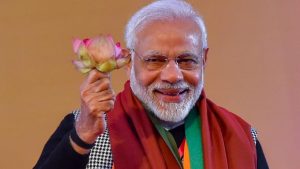
ndia Today-Axis My India poll on Sunday predicted that NDA government is expected to gain a landslide majority in the 2019 general election and Narendra Modi is likely to get a second term as Prime Minister. The poll predicts NDA to win between 339 and 365 seats while the UPA was projected to win between 77 and 108 seats.
Here are ten key takeaways:
First, if the results of the exit poll stand, 2019 was a wave election-a wave in favour of Prime Minister Modi. The vote share of NDA (BJP plus allies) is expected to increase from 39% in 2014 to 45% in 2019, a significant 6% swing in the favour of the ruling party.
Second, BJP is yet again expected to sweep the Hindi Heartland. Of the total 226 seats in the Hindi belt, Axis My India projects NDA winning 188.
Third, the saffron party is effectively sweeping all regions except the South, where NDA is expected to win just 24 of 131 seats.
Fourth, Modi’s charisma is predicted to beat the caste arithmetic in the politically important state of Uttar Pradesh which sends 80 MPs in the Lok Sabha. The poll predicts NDA winning 62-68 seats while the SP-BSP-RLD pre-poll alliance – mahagathbandhan – is expected to win just 10-16 seats. Axis My India projects a 4% point swing in favour of the BJP, with its vote share increasing from 44% in the 2014 election to 48% in 2019. The expected gain comes from the loss of mahagathbandhan’s vote share, which declined from 43% in 2014 to 39% in 2019.
Fifth, the BJP is making significant inroads in West Bengal and Odisha, the poll suggests: the Mamata Banerjee led Trinamool Congress and Naveen Patnaik led Biju Janata Dal is set to lose the home turfs to the BJP. In Bengal, BJP’s tally is expected to rise from two of the total 42 seats in 2014 to between 19 and 23 seats in 2019 while Trinamool’s share can go down from 34 to between 19 and 22 seats. Similarly, in Odisha, where the BJP won just one seat of the total 21 seats in 2014, Axis My India is projecting the NDA to win between 15 and 19 seats in 2019 while the BJD between 2 and 6 seats, down from 20 in 2014.
Sixth, NDA is retaining most of its stronghold seats. We define stronghold seats as the ones which the party had won in the last three Lok Sabha elections: 2004, 2009 and 2014. Of the 53 such strongholds seats for the NDA, it is retaining 44. But UPA is losing 12 of the 18 stronghold seats. NDA is also expected to win 63 of the 92 swing seats, the seats that switched hands in every Parliamentary election since 2004.
Seventh, BJP is sweeping at least 12 states in 2019, the poll predicts. Why did people vote for the NDA government? 62% of the survey respondents said they prefer the NDA at the centre because of the good work done by the Modi regime. Another 29% voted in the name of Modi.
Eighth, the vote share preferences for UPA and NDA do not change as across various income groups and age groups, meaning rich or poor, old or young, it didn’t matter: the support for Modi cuts across all sections across various groups in these categories. However, there is a slight difference with the geographical region: 49% of urban respondents voted for BJP as compared to 44% respondents in rural areas.
Ninth, for 37% of respondents, the Prime Ministerial candidate was the most important factor while casting their vote while 25% voted on the basis of the local candidate. Only 3% of the respondents said they voted based on the promises made by the party and its manifesto.
Tenth, exit poll survey data reveals the significance of multi-phase month-long poll campaigns. 43% of respondents said they made their final decision to vote either on the day of voting (14%) or a few days ago / after community meeting (29%). 31% said they were loyal voters and had always voted for the same party.
Leave a Reply